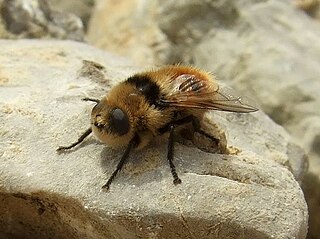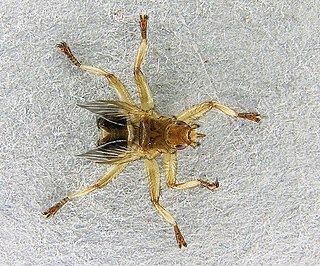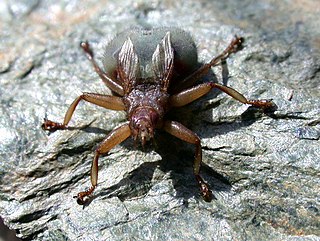
Flies are insects of the order Diptera, the name being derived from the Greek δι- di- "two", and πτερόν pteron "wing". Insects of this order use only a single pair of wings to fly, the hindwings having evolved into advanced mechanosensory organs known as halteres, which act as high-speed sensors of rotational movement and allow dipterans to perform advanced aerobatics. Diptera is a large order containing an estimated 1,000,000 species including horse-flies, crane flies, hoverflies, mosquitoes and others, although only about 125,000 species have been described.

Hippoboscoidea is a superfamily of the Calyptratae. The flies in this superfamily are blood-feeding obligate parasites of their hosts. Four families are often placed here:

Botflies, also known as warble flies, heel flies, and gadflies, are a family of flies known as the Oestridae. Their larvae are internal parasites of mammals, some species growing in the host's flesh and others within the gut. Dermatobia hominis is the only species of botfly known to parasitize humans routinely, though other species of flies cause myiasis in humans.

Horse-flies and deer flies are true flies in the family Tabanidae in the insect order Diptera. The adults are often large and agile in flight. Only female horseflies bite land vertebrates, including humans, to obtain blood. They prefer to fly in sunlight, avoiding dark and shady areas, and are inactive at night. They are found all over the world except for some islands and the polar regions. Both horse-flies and botflies (Oestridae) are sometimes referred to as gadflies.

The Conopidae, also known as the thick-headed flies, are a family of flies within the Brachycera suborder of Diptera, and the sole member of the superfamily Conopoidea. Flies of the family Conopidae are distributed worldwide in all the biogeographic realms except for the poles and many of the Pacific islands. About 800 species in 47 genera are described worldwide, about 70 of which are found in North America. The majority of conopids are black and yellow, or black and white, and often strikingly resemble wasps, bees, or flies of the family Syrphidae, themselves notable bee mimics. A conopid is most frequently found at flowers, feeding on nectar with its proboscis, which is often long.

A black fly or blackfly is any member of the family Simuliidae of the Culicomorpha infraorder. It is related to the Ceratopogonidae, Chironomidae, and Thaumaleidae. Over 2,200 species of black flies have been formally named, of which 15 are extinct. They are divided into two subfamilies: Parasimuliinae contains only one genus and four species; Simuliinae contains all the rest. Over 1,800 of the species belong to the genus Simulium.

Hippoboscidae, the louse flies or keds, are obligate parasites of mammals and birds. In this family, the winged species can fly at least reasonably well, though others with vestigial or no wings are flightless and highly apomorphic. As usual in their superfamily Hippoboscoidea, most of the larval development takes place within the mother's body, and pupation occurs almost immediately.

Lipoptena cervi, the deer ked or deer fly, is a species of biting fly in the family of louse flies, Hippoboscidae. These flies are commonly encountered in temperate areas of Europe, Siberia, and northern China. They have been introduced to North America. They are parasites of elk, deer, and other deer family members, burrowing through the fur and sucking the blood of the host animals. Adults are only 5–7 mm (0.20–0.28 in) in length and brownish in colour. Their bodies are flat and elastic, making their removal difficult. L. cervi is a poor flier and can only fly for short distances. Once the insect reaches its target, it sheds its wings and starts burrowing through the fur.

Crataerina pallida, the swift lousefly, is a species of biting fly in the family of louse flies Hippoboscidae. These flies are commonly encountered in the nests of the common swift in Europe and Asia.

Crataerina is a genus of louse flies in the family Hippoboscidae. All are parasites of birds, feeding on the blood of various species of Apodidae (swifts) and Hirundinidae. The genus is sometimes spelled Craterina.
Hippoboscinae is a subfamily of the fly family Hippoboscidae. All are parasitic, and unlike some other members of the Hippoboscidae, all Hippoboscinae are winged species.
Lipoptena mazamae, the Neotropical deer ked, is a fly from the family Hippoboscidae. They are blood-feeding parasites of the white-tailed deer - Odocoileus virginianus in the southeastern United States and Central America, the red brocket deer - Mazama americana in Mexico to northern Argentina, and also an incidental parasite of domestic cattle, Cougars - Puma concolor, and man.

Lipoptena depressa, or the Western American deer ked, is species of fly in the family Hippoboscidae. The flies are blood-feeding ectoparasites of mule deer, Odocoileus hemionus and white-tailed deer, Odocoileus virginianus. They are found in the western United States and Canada.
Neolipoptena ferrisi, or the Pacific deer ked, is a species of fly from the family Hippoboscidae. They are blood-feeding parasites of the mule deer - Odocoileus hemionus, the white-tailed deer - Odocoileus virginianus & The Pronghorn - Antilocapra americana. They are found from British Columbia, Canada, to Baja California, Mexico. and Australia.
Hippobosca equina, also known as the forest fly or New Forest fly, is a biting fly from the family Hippoboscidae. They are blood-feeding ectoparasites of primarily horses and other large mammals including cattle. It is a permanently fully winged fly, not shedding its wings on finding its host, as in some other Hippoboscidae. With its wings retained, it may thus fly away from its host to deposit its larvae. They are good fliers.

Hippobosca is a genus of flies in the family Hippoboscidae. There are seven known species. There are numerous synonyms.

Pseudolynchia canariensis, the pigeon louse fly or pigeon fly, is a species of biting fly in the family of louse flies, Hippoboscidae.

Melophagus is a genus of flies in the family Hippoboscidae. All are wingless.

Many species of flies of the two-winged type, Order Diptera, such as mosquitoes, horse-flies, blow-flies and warble-flies, cause direct parasitic disease to domestic animals, and transmit organisms that cause diseases. These infestations and infections cause distress to companion animals, and in livestock industry the financial costs of these diseases are high. These problems occur wherever domestic animals are reared. This article provides an overview of parasitic flies from a veterinary perspective, with emphasis on the disease-causing relationships between these flies and their host animals. The article is organized following the taxonomic hierarchy of these flies in the phylum Arthropoda, order Insecta. Families and genera of dipteran flies are emphasized rather than many individual species. Disease caused by the feeding activity of the flies is described here under parasitic disease. Disease caused by small pathogenic organisms that pass from the flies to domestic animals is described here under transmitted organisms; prominent examples are provided from the many species.
Hippobosca rufipes is a species of fly in the family Hippoboscidae. It is found in southern Africa.














